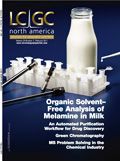An Emerging Leader: One Year Later
LCGC North America
An interview with Jared Anderson of the University of Toledo.
What first intrigued you about chromatography? Please tell us about some of your early research.
Anderson: Well, my earliest research experience with chromatography went back to my sophomore year in undergrad when I was doing some gas chromatography work. I was asked to separate two isomers of a photoreactive compound so I was using packed column GC and collecting the fractions of the isomers in Pasteur pipettes, and then using those fractions for UV and NMR experiments. I then went on, when I was an undergrad in another laboratory, to do some analytical extractions of humic compounds found in soil samples and to do some GC–MS. That was when I really developed a pretty strong passion for chromatography. I went on to graduate school and ended up in the lab of Dan Armstrong, of course a world-renowned chromatographer. From then on I just took more of a liking to chromatography and got into doing more GC, chiral GC, HPLC, and so on.

Jared Anderson University of Toledo
Since winning LCGC's Emerging Leader Award last year, you were also honored with the 2009–2010 Faculty Excellence Award from the College of Arts & Sciences. Has winning these awards had an impact on your research or funding?
Anderson: Well first of all, it was a great honor to be chosen for LCGC's Emerging Leader Award. When I was an undergraduate student there was an analytical course I took where the professor used to give us articles from LCGC. So, at a very early stage of my undergraduate career I was aware of LCGC and it was a great educational magazine. So to be chosen as an emerging leader award winner from such a reputable magazine, I was so honored. Also, to be chosen for the Faculty Excellence Award at my home institution was also great. I think what helps me in the research aspect is to know that I can continue doing the things that I really enjoy — that is, going off in new directions and research, to start to examine new projects or new ideas that I once thought were outside of my expertise. I can read up more about those, arm myself with a great lab of grad students, and start to explore different areas. I think that's really what being awarded these honors allows you to do: It gives you the confidence to look at areas of research that you think are very important and that maybe when you first started out building your lab you thought, "Maybe I shouldn't go into those areas because I'll be met with many obstacles." But now, you know that the community respects you and that you can start to go into these different areas.
In your group's research on solid-phase microextraction (SPME), you developed polymeric ionic liquid (PIL)-based materials as SPME sorbent coatings. Can you discuss the process you went through developing those coatings?
Anderson: Well, I was always really interested in solid-phase microextraction. I never used SPME when I worked in Dan Armstrong's group. So when I started my independent career I decided to do so, since I had worked with ionic liquids and materials before in Dan's group and I was always interested in combining ionic liquids as solvent systems with sample prep. When I started at the University of Toledo, I had three very good grad students that joined my group and we started working on trying to develop the ionic liquids that were compatible with SPME. Of course SPME is a very popular technique, developed by Janusz Pawliszyn at the University of Waterloo (Ontario, Canada).
We went into this area not knowing a lot about how to make these fibers stable, and we were discouraged at first when we started designing the ionic liquids. We found that when we made them as coding materials for SPME and started to do our desorption and GC, the ionic liquid materials would flow off the fiber and we would get very poor reproducibility in our extractions. That's when we started to design new polymeric ionic liquids in which we could polymerize the monomers of the ionic liquid to give the material more strength and make it more resilient to flowing at higher temperatures during the desorption step. It took us some time to get the polymerization chemistry down and choose the right monomers, but eventually we made some coatings that work very well when compared to other commercial coatings available.
How were these materials an improvement over previous SPME sorbents?
Anderson: Some of the improvements that these have over commercial materials is that we can design the properties of the monomer of the ionic liquid to interact specifically with the analytes that we want to extract out of the matrix. For example, we've designed some newer generation polymers in which we add specific functional groups to the polymer and those groups will interact, or react in some cases, with an analyte like carbon dioxide, and we can selectively extract the carbon dioxide out of a gas sample. These are some examples that we've been working on in a variety of different matrices, from extracting pollutants from water or extracting carbon dioxide, methane, or nitrogen from gas. Now we're starting to work on extracting borates from water and genotoxic impurities from pharmaceutical formulations.
This interview was edited for length and clarity.
Hear the rest of this interview at www.chromatographyonline.com

Regulatory Deadlines and Supply Chain Challenges Take Center Stage in Nitrosamine Discussion
April 10th 2025During an LCGC International peer exchange, Aloka Srinivasan, Mayank Bhanti, and Amber Burch discussed the regulatory deadlines and supply chain challenges that come with nitrosamine analysis.













